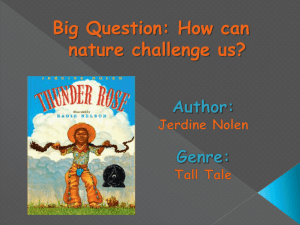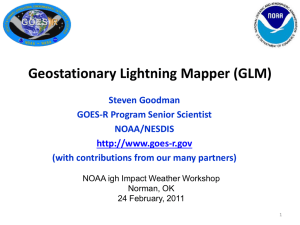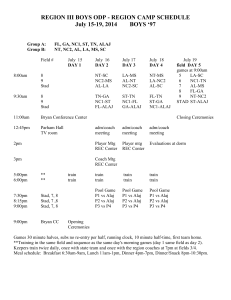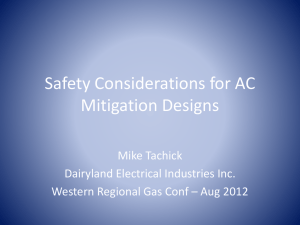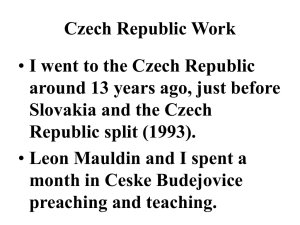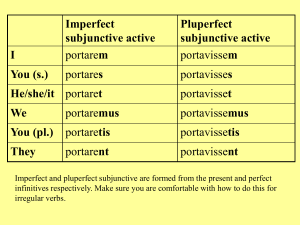pptx
advertisement
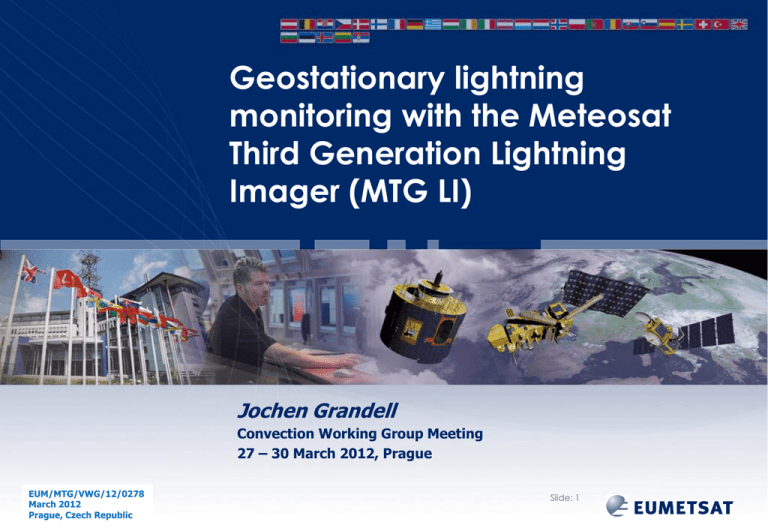
Geostationary lightning monitoring with the Meteosat Third Generation Lightning Imager (MTG LI) Jochen Grandell Convection Working Group Meeting 27 – 30 March 2012, Prague EUM/MTG/VWG/12/0278 EUM/ March Issue 2012 <No.> Prague, <Date>Czech Republic Slide: 1 Topics of Presentation • Lightning Detection from Space – from LEO to GEO observations • EUMETSAT Meteosat Third Generation (MTG) – Lightning Imager • Concept • Product processing • Challenges • User Readiness • Summary EUM/MTG/VWG/12/0278 EUM/ March Issue 2012 <No.> Prague, <Date>Czech Republic Topics of Presentation • Lightning Detection from Space – from LEO to GEO observations • EUMETSAT Meteosat Third Generation (MTG) – Lightning Imager • Concept • Product processing • Challenges • User Readiness • Summary EUM/MTG/VWG/12/0278 EUM/ March Issue 2012 <No.> Prague, <Date>Czech Republic Lightning Detection from Space – from LEO to GEO Feasibility of lightning detection from space by optical sensors has been proven by NASA instruments since 1995 on low earth orbits (LEO) OTD (1995-2000) Results from LIS/OTD: Global lightning distribution Annual flash density LIS (1997-present) EUM/ Issue <No.> <Date> Lightning Detection from Space – from LEO to GEO GEO lightning missions in preparation by several agencies (in USA, Europe, China) for this decade... ...all of these are building on LIS/OTD heritage Geostationary Lightning Mapper (GLM) on GOES-R (USA) Lightning Imager (LI) on MTG (Europe) Geostationary Lightning Imager (GLI) on FY-4 (China) 2015 2018 2014 ? EUM/MTG/VWG/12/0278 EUM/ March Issue 2012 <No.> Prague, <Date>Czech Republic The MTG Lightning Imager (LI) The LI on MTG measures Total Lightning: Cloud-to-Cloud Lightning (IC) and Cloud-to-Ground Lightning (CG) Main benefit from GEO observations: homogeneous and continuous observations delivering information on location and strength of lightning flashes to the users with a timeliness of 30 seconds LIS/OTD flash density in the MTG LI field of view EUM/ Issue <No.> <Date> Main objectives are to detect, monitor, and extrapolate in time: • • • Development (Intensity/Movement) of active convective areas Monitoring of storm lifecycle Lightning climatology & Chemistry (NOx production) GEO observation of lightning is complementary to ground-based networks, some of which are for local applications very good ...Air Traffic is one area of application, and not just around major airports... EUM/ Issue <No.> <Date> Slide: 7 Topics of Presentation • Lightning Detection from Space – from LEO to GEO observations • EUMETSAT Meteosat Third Generation (MTG) – Lightning Imager • Concept • Product processing • Challenges • User Readiness • Summary EUM/MTG/VWG/12/0278 EUM/ March Issue 2012 <No.> Prague, <Date>Czech Republic Detection of a Lightning Optical Signal • Lightning with a background signal changing with time: Radiation energy Background Lightning signal Day Night Time • Lightning on top of a bright background is not recognised by its bright radiance, but by its transient short pulse character • For detection of lightning, a variable adapting threshold has to be used for each pixel which takes into account the change in the background radiance • (in LIS: background calculated as a moving average) EUM/MTG/VWG/12/0278 EUM/ March Issue 2012 <No.> Prague, <Date>Czech Republic Slide: 9 From aaLightning Lightning Optical Events From Optical Signal Signalto toMTG MTGLILI Events • Detection of events in a nutshell: Background scene tracking and removal Thresholding Event detection • Output (=events) of the Lightning Imager at L0 is two-fold: • True lightning events (triggered by a lightning optical signal) • False events (not related to lightning) EUM/MTG/VWG/12/0278 EUM/ March Issue 2012 <No.> Prague, <Date>Czech Republic False event filtering needed in L0-L1 processing Spatial Pattern of Lightning from Space • Characteristics: – Size scales with cloud thickness above source – Mean area of lightning pulses corresponds well to a 10 km x 10 km footprint “MTG LI Events” 1. 2. 3. Optical pattern of lightning on cloud surface (observed from space shuttle) EUM/MTG/VWG/12/0278 EUM/ March Issue 2012 <No.> Prague, <Date>Czech Republic Background scene tracking and removal Thresholding Event detection etc... Possible schema of detected lightning pulses Topics of Presentation • Lightning Detection from Space – from LEO to GEO observations • EUMETSAT Meteosat Third Generation (MTG) – Lightning Imager • Concept • Product processing • Challenges • User Readiness • Summary EUM/MTG/VWG/12/0278 EUM/ March Issue 2012 <No.> Prague, <Date>Czech Republic Product processing in a nutshell MTG LI Product Processing – L1b and L2 products • The following products are resulting from the L1b processing: – Events with geolocation, UTC time stamp and calibrated radiance – background images, mainly supporting navigation • The baseline L2 product, which is a result of clustering of events in time and space, consists of: – Groups (representing lightning strokes) – Flashes (1st priority for many users) EUM/MTG/VWG/12/0278 EUM/ March Issue 2012 <No.> Prague, <Date>Czech Republic Example L2 Sequence: “Events” “Groups” “Flashes” From events/groups/flashes towards DENSITY (1) • For a quick-look, a forecaster or other operational user might prefer a density product. • Can be based on: • Events • groups • flashes • ...and with a variety of temporal windows EUM/MTG/VWG/12/0278 EUM/ March Issue 2012 <No.> Prague, <Date>Czech Republic Events density simulation based on converted LINET data from 2 July 2009 (15 minutes density) Slide: 14 From events/groups/flashes towards DENSITY (2) Animation of EVENT DENSITY simulation Based on converted LINET data from 2 July 2009 (15 minutes density) EUM/ Issue <No.> <Date> Slide: 15 Topics of Presentation • Lightning Detection from Space – from LEO to GEO observations • EUMETSAT Meteosat Third Generation (MTG) – Lightning Imager • Concept • Product processing • Challenges • User Readiness • Summary EUM/MTG/VWG/12/0278 EUM/ March Issue 2012 <No.> Prague, <Date>Czech Republic Challenge for processing: “False Events” • False events are typically caused by: • High energy particle collisions • Noise (instrument, spacecraft etc) • Solar glint • Spacecraft motion (“jitter”) • Specific filters are required for each case: Radiation filter Shot noise/coherency filter Solar glint filter Contrast filter Rough order of severity (based on GLM analysis): Spacecraft motion, Photon/electronics noise, Solar glint, Radiation EUM/MTG/VWG/12/0278 EUM/ March Issue 2012 <No.> Prague, <Date>Czech Republic Topics of Presentation • Lightning Detection from Space – from LEO to GEO observations • EUMETSAT Meteosat Third Generation (MTG) – Lightning Imager • Concept • Product processing • Challenges • User Readiness • Summary EUM/MTG/VWG/12/0278 EUM/ March Issue 2012 <No.> Prague, <Date>Czech Republic User Readiness (1) • User readiness, as discussed here is to be understood as activities similar to what NOAA is attempting with the "GOES-R Proving Ground" framework of activities. • Within this framework, an approach of creating "pseudo-GLM" data based on averaging and resampling ground-based Lightning Mapping Array (LMA) lightning density data has been developed: http://www.goes-r.gov/users/pg-activities.html • This “pseudo-GLM” data has been provided to forecasters in real-time along with other data to support their daily work. EUM/MTG/VWG/12/0278 EUM/ March Issue 2012 <No.> Prague, <Date>Czech Republic Slide: 19 User Readiness (2) • The idea is to make the forecaster end-user aware, and used to, the kind of product that would be available from the GLM. • This is not perfect proxy data: It merely gives an "impression" of how the real GLM product could look like. • EUMETSAT is planning a similar activity by using the existing proxy data methodology with the ground-based LINET data in Europe • A near-real time application of the proxy data will be needed • Data to be disseminated to selected Meteorological Services for evaluation and feedback EUM/MTG/VWG/12/0278 EUM/ March Issue 2012 <No.> Prague, <Date>Czech Republic Slide: 20 Topics of Presentation • Lightning Detection from Space – from LEO to GEO observations • EUMETSAT Meteosat Third Generation (MTG) – Lightning Imager • Concept • Product processing • Challenges • User Readiness • Summary EUM/MTG/VWG/12/0278 EUM/ March Issue 2012 <No.> Prague, <Date>Czech Republic Summary • One of the new instruments on the Meteosat Third Generation (MTG) is the Lightning Imager (LI), • geostationary services from 2017 onwards • continuous lightning observation (CG+CC) over almost the full disk (at 0 deg). • Algorithm and processor development for baseline L2 products (event/group/flash –tree) currently ongoing • Supported by a MTG Lightning Imager Science Team (LIST) set up in 2009 • Interacting with potential users (such as CWG) an important topic in coming years EUM/MTG/VWG/12/0278 EUM/ March Issue 2012 <No.> Prague, <Date>Czech Republic MTG Lightning Imager Science Team (LIST) • The MTG LI Science Team currently consists of the following members: – – – – – – – – – N.N. (MetOffice – UK) Daniele Biron (USAM – Italy) Eric Defer (LERMA – France) Ullrich Finke (U. Hannover – Germany) Hartmut Höller (DLR – Germany) Philippe Lopez (ECMWF) Douglas Mach (NASA – USA) Antti Mäkelä (FMI – Finland) Serge Soula (Laboratoire d'Aerologie – France) EUM/MTG/VWG/12/0278 EUM/ March Issue 2012 <No.> Prague, <Date>Czech Republic EUM/MTG/VWG/12/0278 EUM/ March Issue 2012 <No.> Prague, <Date>Czech Republic FER = 1 000 /s FER = 30 000 /s FER = 200 000 /s How noise looks like on a 0.5s period All noise events in 500 milliseconds! FER = 5 000 /s FER = 40 000 /s FER = 300 000 /s FER = 10 000 /s FER = 100 000 /s FER = 400 000 /s EUM/ Issue <No.> <Date> Slide: 25 Background radiance: Solar reflection on clouds and ground surfaces • Background radiation from clouds determines the signal to noise ratio for detection of transient lightning signals • Challenges: • Day-night contrast in FOV • Microvibrations (fast changing background) • Sun glint 0 UTC EUM/ Issue <No.> <Date> 12 UTC 22 UTC Background radiance: Solar reflection on clouds and ground surfaces • Background radiation from clouds determines the signal to noise ratio for detection of transient lightning signals • Challenges: • Day-night contrast in FOV • Microvibrations (fast changing background) • Sun glint 0 UTC EUM/ Issue <No.> <Date> 12 UTC 22 UTC Background radiance: Solar reflection on clouds and ground surfaces • Background radiation from clouds determines the signal to noise ratio for detection of transient lightning signals • Challenges: • Day-night contrast in FOV • Microvibrations (fast changing background) • Sun glint 0 UTC EUM/ Issue <No.> <Date> 12 UTC 22 UTC Background radiance: Solar reflection on clouds and ground surfaces • Background radiation from clouds determines the signal to noise ratio for detection of transient lightning signals • Challenges: • Day-night contrast in FOV • Microvibrations (fast changing background) • Sun glint 0 UTC EUM/ Issue <No.> <Date> 12 UTC 22 UTC Background radiance: Solar reflection on clouds and ground surfaces • Background radiation from clouds determines the signal to noise ratio for detection of transient lightning signals • Challenges: • Day-night contrast in FOV • Microvibrations (fast changing background) • Sun glint 0 UTC EUM/ Issue <No.> <Date> 12 UTC 22 UTC Background radiance: Solar reflection on clouds and ground surfaces • Background radiation from clouds determines the signal to noise ratio for detection of transient lightning signals • Challenges: • Day-night contrast in FOV • Microvibrations (fast changing background) • Sun glint 0 UTC EUM/ Issue <No.> <Date> 12 UTC 22 UTC Effect of Microvibrations (“jitter”) on Lightning Detection Assuming that this is what the Lightning Imager is looking at... Darker (ocean) background Cloud Background energy Cloud Distance Darker (ocean) background EUM/ Issue <No.> <Date> Slide: 32 Effect of Microvibrations (“jitter”) on Lightning Detection What if the instrument (satellite) moves slightly between integration frames...? Background energy Background removal (Frame #2 – Frame #1) But this is not lightning! Frame #1 Cloud Distance EUM/ Issue <No.> <Date> Darker (ocean) background Frame #2 Distance Slide: 33 Meteosat Third Generation (MTG): Continuity and Evolution of EUMETSAT Services 2002 1977 MOP/MTP 2017 and 2019 MSG MSG MOP/MTP MTG-I and MTG-S Observation mission: - MVIRI: 3 channels Observation missions: - SEVIRI: 12 channels - GERB Spinning satellite Class 800 kg Spinning satellite Class 2-ton Implementation of the EUMETSAT Mandate for the Geostationary Programme EUM/ Issue <No.> <Date> Observation missions: - Flex.Comb. Imager: 16 channels - Infra-Red Sounder - Lightning Imager - UVN 3-axis stabilised satellites Twin Sat configuration Class 2,5 - 3 ton Atmospheric Chemistry Mission (UVN-S4): via GMES Sentinel 4 MTG in Orbit Deployment Scenario MSG-4 MTG-I1 Dec. 2016 MTG-I2 Dec. 2022 MTG-I3 Jan. 2025 MTG-I4 Dec. 2029 2017 – 2038: 20 years of Operational Service – Imaging Missions MTG-S1 June 2018 MTG-S2 June 2026 EUM/ Issue <No.> <Date> 2019 – 2035: 15.5 years of Operational Service – Sounding Mission MTG Lightning Imager Science Team (LIST) • EUMETSAT has identified the need to establish a scientific baseline for the operational processor of the MTG mission. • In support of these scientific developments, a science team has been established – MTG LI Science Team (LIST). • The main objectives of the team is to: • Assist EUMETSAT with the implementation of the MTG LI L2 scientific baseline processor. • Prepare an Algorithm Theoretical Baseline Document (ATBD). It includes also a description of the proxy dataset, to be used for algorithm development and processor development. • The ATBD will be subject for review at the Preliminary Design Review (PDR) concluding the MTG system Phase B activities EUM/ Issue <No.> <Date> Slide: 36 EUMETSAT, MTG LI and LINET • EUMETSAT has now several years of experience in cooperating with Nowcast and DLR in using LINET data: • Especially in developing proxy data... • ...Latest activity has been in contributing to the CHUVA campaign in Brazil with the mobile LINET unit (DLR), which should after evaluation of the joint measurements with LMA and LIS allow a further enhancement of the proxy data • Based on these experiences, it looks like LINET data could play an important role in “user readiness” activities as well as validation/monitoring of the operational product(s) from the MTG LI EUM/ Issue <No.> <Date> Slide: 37 MTG LI – Main Mission Requirements • Wavelength 777.4 nm • Sensitivity pulses as small as 100 km2 with energies down to 4 µJ/(m2sr) should be detected • Spatial sampling Less or equal to 10 km at 45oN for the sub-satellite longitude • Detection Efficiency 70% in average, 90% over central Europe, 40% as a minimum over EUMETSAT member states • False Alarm Rate 2.5 false flashes/s • Background images every 60 seconds EUM/ Issue <No.> <Date>


